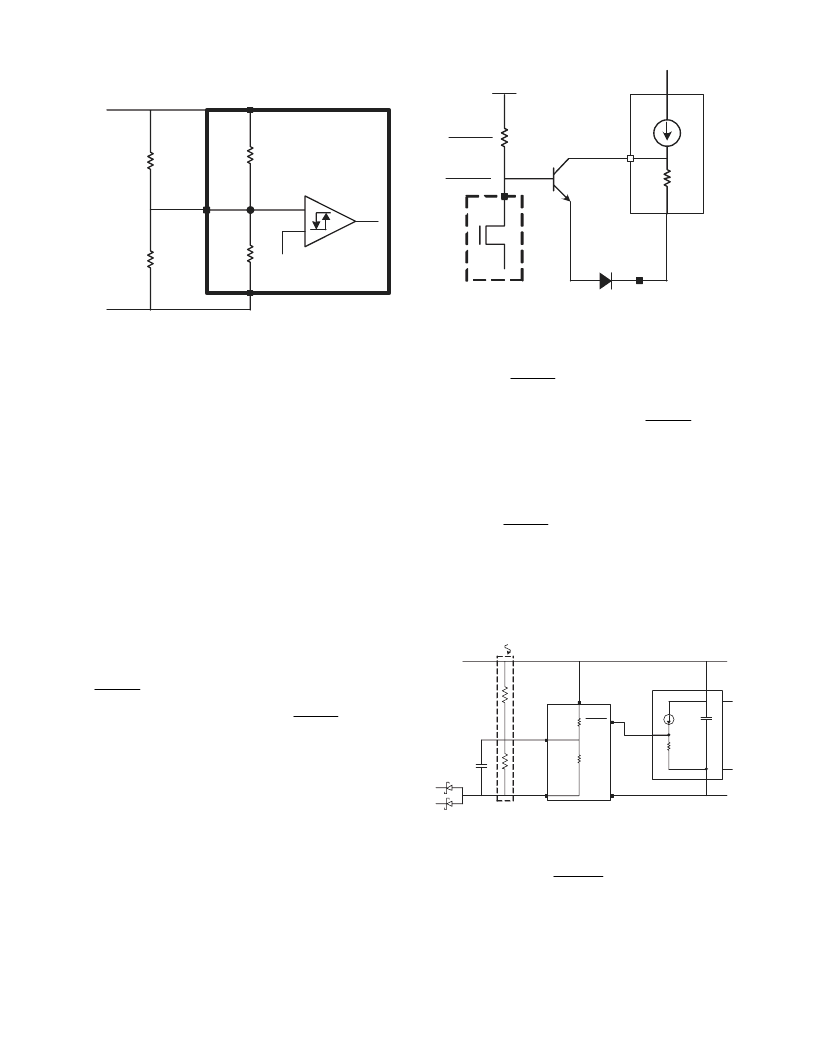- 您現(xiàn)在的位置:買賣IC網(wǎng) > PDF目錄385409 > HV111 (Supertex, Inc.) Inrush Limiter/Circuit Breaker/Hotswap Controller IC PDF資料下載
參數(shù)資料
| 型號: | HV111 |
| 廠商: | Supertex, Inc. |
| 元件分類: | 脈沖抑制器 |
| 英文描述: | Inrush Limiter/Circuit Breaker/Hotswap Controller IC |
| 中文描述: | 浪涌電流限制器/斷路器/熱插拔控制器IC |
| 文件頁數(shù): | 4/9頁 |
| 文件大?。?/td> | 551K |
| 代理商: | HV111 |

HV111
Programming UVLO
GND
Figure 3
Programming UVLO
PWRGD
Internal to
HV111
DRAIN
V
NN
D
V
PP
1mA
V
PP
R
1
Q
1
Enable
V
PP
R1
R2
-48V
UVLO
116k
2.4M
1.2V
V
NN
Figure 4
PWRGD Active High
The above circuit works as follows for ACTIVE HIGH
operation. If the PWRGD is low, then the current sourced by
the pullup is pulled to V
and the BJT, Q1, is starved for
base drive current and remains off. The reverse Vbe voltage
is protected by the series diode, D1. If PWRGD is open,
then the current has no alternative but to flow into the base
and thus connects the DC/DC ENABLE pin to the DC/DC
ground reference (DRAIN pin of the HV111). As the clamp is
inverting, therefore proper ACTIVE high polarity is
established.
The UVLO/ENABLE pin makes it easy to override the
internal 26V nominal under voltage. The 26V nominal setting
is produced by a resistor divider of 2.4M
and 116k. These
are 20% resistors, however, 1% accurate relative to one
another. To override there are two options. The first is to
simply use a much lower impedance divider, for example
200k, and largely ignore the internal divider. Alternatively,
the internal impedance may be taken into a account in the
network and the UVLO calculated as:
V
PP
*(R2||116k) / (R1||2.4M
+R2||116k)
Keep in mind, however, that the 30% variation on the
internal resistors will reduce the accuracy of the UVLO set
point using this approach.
The resistor, R1, should be sized as V
/1mA to ensure that
the maximum PWRGD transistor current is not exceeded
(remember to use the maximum possible V
PP
your circuit will
see rather than the nominal value of V
PP
).
Further, Q1 must be rated for operation to maximum
expected V
PP
and have a beta large enough that the
minimum V
min/V
max*1mA*
β
> Ipullupmax of the
DC/DC converter (or external resistor if used).
Note that the UVLO/ENABLE pin may also be used as an
enable with a nominal 1.20V trip point and 10% of
hysteresis.
PWRGD Active High or Active Low
(for DC/DC HV Interface / Enable)
The PWRGD pin is an open drain active low MOSFET which
is enabled when the gate voltage on the internal power
MOSFET reaches its full on voltage. The PWRGD output is
nominally ACTIVE LOW, however, the simple circuit shown
(Figure 4) can convert it to active high operation.
BA
Also shown in Figure 5 is decoupling capacitor is not strictly
required, a fast dv/dt on PWRGD bar can result in coupling
that can glitch the UVLO pin. This decoupling capacitor
ensures that glitches will be eliminated.
Figure 5
PWRGD Enable
UVLO/
V
NN
V
PP
DRAIN
PWRGD
GND
optional
ENABLE
DC/DC
GND
V
O
HV111
-48V
T
4
相關(guān)PDF資料 |
PDF描述 |
|---|---|
| HV111K4 | Inrush Limiter/Circuit Breaker/Hotswap Controller IC |
| HV219 | Low Charge Injection 8-Channel High Voltage Analog Switch |
| HV219FG | Low Charge Injection 8-Channel High Voltage Analog Switch |
| HV219PJ | Low Charge Injection 8-Channel High Voltage Analog Switch |
| HV219X | Low Charge Injection 8-Channel High Voltage Analog Switch |
相關(guān)代理商/技術(shù)參數(shù) |
參數(shù)描述 |
|---|---|
| HV111K4 | 功能描述:熱插拔功率分布 3/1 Controller IC RoHS:否 制造商:Texas Instruments 產(chǎn)品:Controllers & Switches 電流限制: 電源電壓-最大:7 V 電源電壓-最小:- 0.3 V 工作溫度范圍: 功率耗散: 安裝風(fēng)格:SMD/SMT 封裝 / 箱體:MSOP-8 封裝:Tube |
| HV113SM-12 | 制造商:SPECTRUM 制造商全稱:Spectrum Microwave, Inc. 功能描述:Voltage Controlled Oscillator |
| HV113T-1 | 制造商:SPECTRUM 制造商全稱:Spectrum Microwave, Inc. 功能描述:Voltage Controlled Oscillator |
| HV116 | 制造商:Apex Tool Group 功能描述:1 IN. X 16 FT HI-VIZ ORANGE SERIES POWER RETURN TAPE |
| HV12 | 制造商:SEMTECH_ELEC 制造商全稱:SEMTECH ELECTRONICS LTD. 功能描述:FAST RECOVERY HIGH VOLTAGE DIODES |
發(fā)布緊急采購,3分鐘左右您將得到回復(fù)。